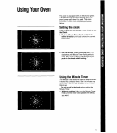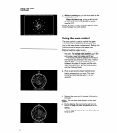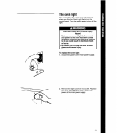
Using Your Oven
Contmued
Broiling tips
l
Use the broiler pan and grid for broiling. They
are designed to drain excess liquid and fat
away from the cooking surface to help prevent
spatter, smoke or fire.
l
If you broil small quantities, you may want to
use a small broiler pan. They are available in
the housewares section of many department
stores.
l
For best broiling results, preheat at BROIL for 5
minutes. Do not preheat with broiler pan in
place.
l
Rack position determines how infra-red rays
cook your food. The lower the position, the
more broiler grid area covered by the rays.
See “Rack position chart” below for more
information.
l
To sear meat, place broiler pan at one of the
higher rack positions so that meat is very near
the flame.
l
Small steaks, hamburger patties, etc., may be
broiled in the higher rack positions.
l
To cook large steaks and other thick cuts of
meat well done, move them to a lower rack
position after searing.
l
Refer to a broiling chart in a reliable cookbook
for correct broiling times.
l
After broiling, remove the broiler pan from the
oven when you remove the food. Drippings will
bake on the pan if it is left in the heated oven.
8
Fire Hazard
l Place meat the correct distance from the
burner. Meat placed too close to the
burner may spatter, smoke, burn or catch
fire during broiling.
l To ensure adequate grease drainage, do
not use cookie sheets or similar pans
for
broiling. Also, covering the broiler grid
with foil is not recommended. Poor
drainage of grease may result in fire. If
foil is used, cut slits in foil to correspond
with all openings in broiler grid. Grease
can then drain away and cool in pan.
Rack position chart
RACK POSITION
FROM BOTTOM
FOOD
3
Rare steaks and
hamburgers
Medium steaks and fish
Well-done foods such as
chicken, lobster, ham
slices and pork chops


















